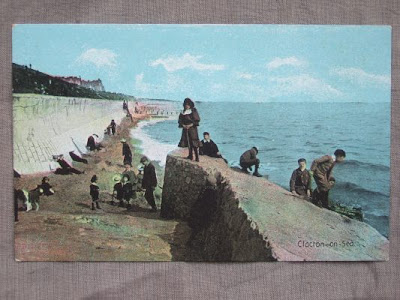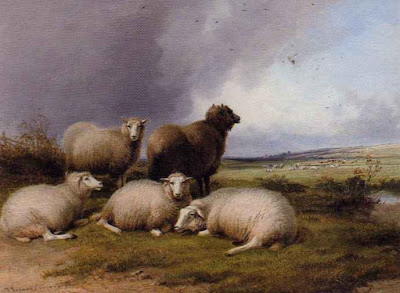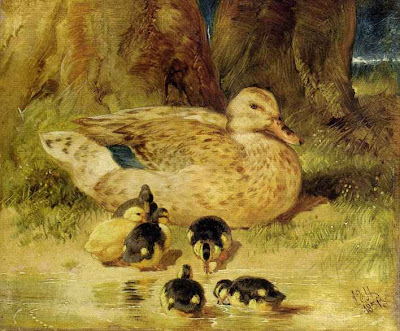
Saturday, November 28, 2009
Wilfrid Gabriel De Glehn
Edward William Cooke

[Mending Nets : Bay of Naples]
signed E W Cooke. RA. 1869 l.r.
oil on canvas
35.5 x 55"
Cooke first visited this area in 1846 and this seems to be his last painting of the coast there. In the late 1860's Cooke was living at Groombridge on the Kent/Sussex border in a house designed for him by Norman Shaw. This painting was exhibited at the RA in 1869 and was well received.
.
1811 - 1880.
Julius Olsson
Friday, November 27, 2009
Robert Gibb
Jacques Emile Blanche
(Sir) George Clausen - The Spreading Tree
Thursday, November 26, 2009
Clacton on Sea
Reynolda to Feature Works of Mid- Nineteenth Century American Expatriates

[John Singer Sargent, "Marchesa Laura Spinola Nunez del Castillo", 1903. Oil on canvas, 34 1/4 x 28 1/4". Courtesy: Barbara B. Millhouse]
Reynolda House Museum of American Art's exhibition "American Expatriates: Cassatt, Sargent, and Whistler" will open Dec. 5, 2009 and will remain on view through Apr. 25, 2010 in the Northeast Bedroom Gallery.
"American Expatriates" focuses on the art of a group of young American artists in the mid-nineteenth century who moved to Europe to live, work and study. At some point in their budding careers, most professional artists felt the lure of the Old World and chose to study in Europe, where the art schools and studios had much more prestigious reputations than the just-emerging academies in their native country. Some, like James McNeill Whistler, Mary Cassatt, and John Singer Sargent, remained in Europe essentially for the rest of their lives
"American Expatriates" focuses on the art of a group of young American artists in the mid-nineteenth century who moved to Europe to live, work and study. At some point in their budding careers, most professional artists felt the lure of the Old World and chose to study in Europe, where the art schools and studios had much more prestigious reputations than the just-emerging academies in their native country. Some, like James McNeill Whistler, Mary Cassatt, and John Singer Sargent, remained in Europe essentially for the rest of their lives
Dorothea Sharp - At the Seaside
Thomas Benjamin Kennington - Amongst the Rocks
Henry Scott Tuke

[Portrait study of Molly Dalymple]
inscribed No.6 ...
oil on canvas
24 1/8 x 20"
.
1858 - 1929.
A portrait of his fellow artists - (Sir) Walter Hamilton-Dalyrmple (1854 - 1920) - daughter done in North Berwick. Tuke painted the mother, wife and daughter - Agnes Mary (known as Molly) - the third of their five children. She was 8 at the time and was entertained by her Grandmother reading fairy stories.
Harold Harvey - A Summer Night
Wednesday, November 25, 2009
Tuesday, November 24, 2009
Sotheby's Sale of American Paintings to be Held in December
Delaroche masterpiece feared lost in war to go on show at National Gallery
Fine Portrait by York's Most Famous Artist Bought by York Art Gallery
Maud Earl - Bulldog

[What We Have We Hold - a portrait of Dimboola the Champion Bulldog]
signed Maud Earl/96 l.r.
oil on canvas
30 x 43"
.
Price Realized £22,500
Maud Earl clearly intended her portrait of the Champion Bulldog of 1896 to evoke a patriotic display of Britain's strength; beyond Dimboola and the Union Jack, ships can be seen off the white cliffs of Dover. The print after this work, issued in 1900, was widely disseminated and became a popular image in England during the early twentieth century. As a sign of how compelling the image became, it was used on the front of a promotional pamphlet after World War I that was published in Canada and which listed several English political and military figures of the time.
Perhaps more than any other artist born in the nineteenth century, Maud Earl was the pre-eminent painter of purebred dogs. William Secord considered that, 'when it came to painting the purebred dog, Emms was far surpassed by his contemporary, Maud Earl, and there can be little doubt that she stands out among the many nineteenth century artists who painted dogs.' (A Breed Apart, Woodbridge, 2001). She was born into an artistic family, the only daughter by the artist George Earl's first wife, Alice Beaumont Rawlins. Her uncle, Thomas Earl, was also a talented painter of horses and other animals. Maud was taught by her father and at the Royal Female School of Art, where she quickly developed her natural talent for capturing the true character of her canine subjects. Her half-brother, Percy, was also an artist who completed many commissions of horses and purebred dogs.
She exhibited regularly in England and Europe, and was a prolific and much sought after artist who painted many of the important dogs of the day, including those belonging to the Royal Family and important dog fanciers. She attributed much of her talent to her natural affinity for her subject, 'You can't paint dogs unless you understand them; I don't mean merely from the fancier's point of view. You must know whether they are happy and comfortable, and if not, why not. You must know how to quiet them when they become excited and nervous. You must know all their little likes and dislikes, and this knowledge comes from long experience.' (The Young Woman, November, 1898). Her works were immensely popular with the public for whom images of the dog were an important reflection of their affection for the animal.
Purebred dogs in late nineteenth century England were extraordinarily popular as new breeds were imported and established, and Maud Earl further reinforced their importance by completing their portraits in oils. In 1897 she had an exhibition in which she showed paintings of forty-eight varieties.
By 1916, she had received international recognition with several solo exhibitions, and her work was widely reproduced both in books and print form. Her work may be loosely divided into four styles, the naturalistic, richly painted portraits of dogs from 1880 to 1900; a highly finished but looser, more sketchy style from 1900 to 1915; what she referred to as her oriental style from about 1916 to the 1920s after she emigrated to the United States; and her late rather stylized portraits of dogs during the 1930s in America. It was during her early years in America when she painted her little-known but elegant paintings of birds, which she considered some of her best work.
The Bulldog is rivalled only by the Mastiff as a contender for England's national breed, and is also one of England's oldest and most beloved dogs. By the 1890s when the present picture was painted, the Bulldog had been a longstanding member of the dog show world. What once had been a strong and tenacious fighter had now become, through selective breeding, a show dog and pet but it was still embodied with the ideology of strength and fortitude and hence was an apt symbol at the time for the power of the British Empire.
The present work was clearly intended to be a patriotic display of Britain's strength and naval capacity with the Champion Bulldog of that year, the British flag and the ships in the background seen off the white cliffs of Dover. The print issued in 1900 after this work was widely disseminated and became a popular image in England during the early twentieth century. As a sign of how compelling the image became, it was used on the front of a promotional pamphlet after World War I that was published in Canada and which listed several English political and military figures of the time.
Dimboola Champion, owned and bred by Mr J S Pybus-Sellon, was whelped on 13th April 1893 and was white with lemon markings. His sire was Stockwell and his dam Dextrine.
Alice Boyd - St Colomba's Farewell to the White Horse

[St Colomba's Farewell to the White Horse]
signed EB 1865/8(?) l.l.
oil on board
13 7/8 x 19.5"
.
1825 - 1897
Price Realized £3,250
Alice Boyd was one of the most interesting women artists in the Pre-Raphaelite circle, although she has inevitably been overshadowed by the figure of William Bell Scott. They met in Newcastle in 1859, when he was master of the Governement School of Design and she was looking for someone to help her develop her artistic talent. Although Scott was married, they fell in love, and a ménage a trois was successfully established whereby Alice spent the winter with the Scotts in London (to which they moved in 1864) and they spent the summer with her at Penkill, her miniature Ayrshire castle. Many works by both artists were included in the Penkill house sale held by Christie's on 15 December 1992.
The picture dates from the period when the Scotts were living at 33 Elgin Road, Notting Hill, their address from the time they settled in London in 1864 until they moved to Bellevue House, Cheyne Walk, Chelsea, in 1870. This ties up with the name of the artist's colourman - William Benham, 9 Devonshire Terrace, Notting Hill, W - who evidently supplied the panel and whose label survives on the back. It shows St Columba on the island of Iona bidding farewell to an old white packhorse which, having a premonition of the Saint's death, has come, weeping bitterly, to receive his blessing. The subject was later treated by another Scottish artist, John Duncan (see John Kemplay, The Paintings of John Duncan, 1994, illustrated p. 109).
The picture's background owes much to the view of the Firth of Clyde and Ailsa Craig that can be seen from the battlements of Penkill Castle.
Monday, November 23, 2009
Anna Lea Merritt - Eve

signed Anna Lea Merritt 1885 l.l.
oil on canvas
30 x 43"
exhibited RA 1885
.
Price Realized £63,650
Exhibited
London, Royal Academy, 1885, no. 126.
The American artist Anna Lea was the first woman to have a painting bought by the Chantrey Bequest. Love Locked Out, now in Tate Britain, was conceived as a monument to her husband, Henry Merritt, who had died within a year of her marriage. She later wrote of the painting: 'I feared people liked it as a symbol of forbidden love, while my Love was waiting for the door of Death to open and the reunion of the lonely pair'.
Born in America, she arrived in London after completing her artistic education in Paris, Rome and Dresden. She often visited America, and the present painting which was known there as Eve overcome by Remorse won accolades when exhibited in Chicago in 1893.
Benjamin Williams Leader - Bettws-y-Coed paintings

[Stepping Stones, Bettws-y-Coed]
signed B. W. Leader / 1862 l.l.
oil on canvas
21 x 29.5"
[On the Llugwy, near Betws-y-Coed, Summer]
1865
oil on board
16 x 24"
.
Stepping Stones, Bettws-y-Coed
Price Realized £8,750
The bright prismatic colours and great attention to detail characterise Stepping Stones, Bettws-y-Coed which was painted in the same year as A Fisherman's Haunt (The Lord Lloyd Webber Collection). The artist revisited the subject the following year on a larger scale (Manchester City Art Gallery no.1934.407)
William Gale - Nazareth
(Arthur) James Stark - View on the Yare, near Thorpe Church
Alfred Stannard

signed A. Stannard. 1867 l.r.
inscribed Pakefield nr Lowestoft
[Pakefield near Lowestoft]
oil on canvas
12 x 18"
.
1806 - 1889.
http://www.artnet.com/artist/663341/alfred-stannard.html
http://www.culturalmodes.norfolk.gov.uk/projects/nmaspub5.asp?page=hitlist&mwsquery=+(+%7BWho%3F%7D+%3D*+%7BStannard,%20Alfred%7D+)+&filename=d%3A%5Cmuseums%5Cmodes%5Cp_finea1.mdf&submitButton=Show+hits
Sunday, November 22, 2009
(Sir) Alfred James Munning - Pike Fishing in January

Price Realized £99,650
signed 'A.J.MUNNINGS/98.' (lower right)
oil on canvas
15 x 12 1/8 in. (38.1 x 30.8 cm.)
Together with a signed letter from the artist to W. Holden White Esq.
Sir Alfred Munnings, An Artist's Life, Museum Press, 1950
S. Booth, Sir Alfred Munnings 1878-1959, Wilson, 1978
Pike fishing in January together with Stranded (Bristol City Art Gallery) were the first pictures that Munnings exhibited at the Royal Academy, when he was merely twenty years old.
This early example of Munnings' preference for plein air observation was vividly described in the artist's autobiography:
'At the School of Art I was already painting still life oils, and soon began, on Saturday afternoons, to carry out box and easel to the country for landscape; but I badly wanted to find a model and do a figure somewhere outside.
In the press room room downstairs at Page Brothers two men were always at work... The younger man "Jumbo" Betts became and friend of mine. We arranged to.. leave on a Saturday (and go) to the river at Lakenham - imagine a quiet chill January afternoon, a grey sky, a sluggish narrow river between rows of bare pollarded willows with pale dead reeds and sedges along either bank. This being a small picture I carried it through in a painting with "Jumbo" Betts the model stamping his feet to keep warm. Hung on the line (at the Royal Academy) and sold for ten guineas - a vast sum' (op.cit., p.71).
The picture will be included in the artist's forthcoming catalogue raisonné, being prepared by Lorian Peralta Ramos.
Detailed below is a transcription of a signed letter from Munnings to W. Holden White, which is attached to the reverse of the canvas.
From Sir Alfred Munnings, P.P.R.A., K.C.V.O.
Castle House,
Dedham,
Colchester, Essex.
11th December, 1950
My Dear Sir,
Thank you for your grand letter. I note you are 'a dammed American*' who has lived and done all sorts of things here for the past seven years, and I note you have read my book, also that you are a brother-in-law of Lord Ismay's. One day if I could have your telephone number I would like to meet you and get a shock with that small picture of 'Pike Fishing in January' which you seem to have. It is most kind of you to write, and I appreciate it.
Yours sincerely,
Alfred Munnings
W. Holden White Esq.
* Your own expression.
http://www.christies.com/LotFinder/lot_details.aspx?from=salesummary&intObjectID=5210443&sid=7a968eaf-2ba8-4124-86ad-966032f806ac
John Atkinson Grimshaw - Au Clair de Lune
Saturday, November 21, 2009
Thomas Bush Hardy
Wilfred Gabriel de Glehn - Tugs at Dusk
Campbell Archibald Mellon
Subscribe to:
Posts (Atom)


















.jpg)




















